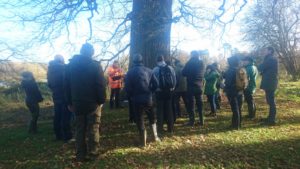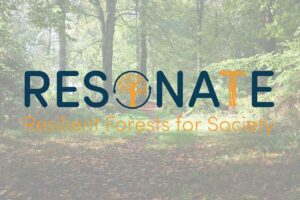Andy Lederer, ICF Development Director, attended 2017 ICF’s East England: Trees and Decay – Conservation and Risk Management event. Andy reports on his experience.
The National Trust site, Hatfield Forest in Essex played host to the Institute’s East England regional meeting on Thursday 23rd November 2017. The event was sold out with delegates coming from far and wide, one delegate made the journey from Brighton to attend. The day was a good balance of trees and decay with discussions surrounding making informed judgements on conservation while managing appropriate risk. Tracy Clarke MICFor organised the day and was heading back to her old stomping ground and home. Tracy lived on the site for more than a decade.
Andrew Coombes FICFor, Director of AT Coombes Associates and Chair of the East England regional committee, welcomed delegates to the day. Henry Bexley, Countryside Manager at Hatfield Forest, gave a brief history of the site and some of the background behind their considerations for the strategic management of the forest for productive woodland, conservation and public interest. The site is the last intact medieval hunting forest, a National Nature Reserve (NNR) since the 1990’s and a SSSI since the 1950’s. The forest covers an area of 424 Ha and is a key veteran tree habitat site. 50% of that area is coppice with the other 50% woodland pasture with a large proportion of veteran pollards. One third of the coppice is under active management, one third is left as unmanaged with the final third, soon to be incorporated into more active management as part of the long term strategic plan. The veteran tree stock in the forest is vast with just less than 1000 veteran pollards with nearly every native species accounted for. The site is open to the public with visitor numbers in excess of 500,000 visitors per year which is nearly a 50% increase compared to figures from ten years ago. With the increase in visitor frequency, especially during the summer months, a healthy balance to ensure appropriate conservation management while reducing the potential of risk to the public needs to be found.
Dr David Lonsdale, plant pathologist and arboricultural consultant, was next to present in the morning. The premise was Trees and Decay: Management for Risk vs Conservation. Dr Lonsdale began with a set of Pierre Raimbault (a scientist, teacher and one of the main proponents of tree morphology) images showing tree development over its life span. Dr Lonsdale delved deeper than just the above and below ground aspects of the trees by incorporating a simple visual representation of the internal structure of the tree through each stage of development. The next stage was to discuss the key differences between sapwood, heartwood and ripewood. They all have different functions and composition, therefore they each respond to fungi in various ways.
Next Henry Bexley outlined the strategic plan for tree management across Hatfield Forest. Henry described the risk matrix employed by the site for tree inspections, both the level of detail required dependent on the individual tree and associated usage zone but the quantity of inspections ranging over a 6 month to five year period. One of the key messages from Henry is how the strategy has evolved with better understanding of visitor footfall across the site, veteran tree management and the topography of the site.
After lunch, the delegates moved outside to forage the forest. The first outdoor session was led by Chris Wright, Senior Arboricultural Consultant at Tim Moya Associates, who has a passionate love for fungi and this passion and knowledge was well conveyed to the group as we hunted for these wonderful heterotrophs and discussed management options of the trees playing host to them.
The second session was delivered by James Chambers, Principal Arboricultural Consultant at Tim Moya Associates, who lives next to Hatfield Forest. James setup a PiCUS demonstration on the Rackham Oak, a large, mature Oak tree. PiCUS is a sonic tomograph machine that measures the speed of sound waves in wood in order to detect decay and cavities in standing trees. Damage, disease, fractures, rot or cavities reduce the elasticity and density of the wood, meaning the acoustic velocity is altered or reduced. The software collates this data to produce an internal image of the cross-section of the tree.
Finally, the day finished with a wander around a small fraction of the forest led by Henry Bexley where specific management approaches in relation to usage zones were highlighted to the group and discussed. Some stunning individual hornbeam pollards were a big talking point during the walk. Some of these pollards seeming to defy the laws of physics.
It was a great day and I would like to extend my thanks to all involved in the delivery and organisation of the day.






